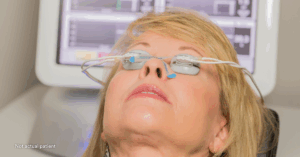
“I have to blink a lot while reading to clear my blurry vision.”
Dry eyes can be uncomfortable, affect your quality of life and lead to permanent vision impairment. Because multiple ocular and medical factors are involved, a comprehensive eye examination with your ophthalmologist is recommended to discuss dry eye disease and treatment options. Patients have vastly different therapeutic responses, so be patient and tenacious. Keep in mind that treating dry eye is a process. Even though there is no cure, there can be a solution.
With mild dry eye, artificial tear drops can supplement reduced tear production and help treat symptoms. Nutritional supplements such as flaxseed or fish oil capsules may also be beneficial for dry eye disease.
For patients with chronic symptoms due to dry eye disease, over-the-counter treatments are often not enough. RESTASIS™, XIIDRA™, and CEQUATM are three FDA-approved prescription eye drops for dry eye and are a valuable treatment option for this condition. RESTASIS™ and CEQUATM combat dry eye disease by helping the eyes produce healthier and more abundant tears. XIIDRA™ is approved to treat the signs and symptoms of dry eye disease.
Other prescription eye drops can also be used to treat the inflammation component of dry eye disease. For some patients, a tiny plug is inserted into a tear drain opening in the lid, which can keep tears on the eye’s surface by slowing the drainage rate from the eye. This procedure is called punctal occlusion.
 LipiFlow is a procedure where a device is applied while covering the eye’s surface to the front and back surface of the eyelids. This device will then warm the contents of the oil glands in the upper and lower lids. When the oil gland contents are warm and liquefied, the device massages the lids to clear the glands and help to improve and restore oil secretion. The effectiveness of the treatment varies based on dry eye type, length of time the patient has had the condition, and its severity.
LipiFlow is a procedure where a device is applied while covering the eye’s surface to the front and back surface of the eyelids. This device will then warm the contents of the oil glands in the upper and lower lids. When the oil gland contents are warm and liquefied, the device massages the lids to clear the glands and help to improve and restore oil secretion. The effectiveness of the treatment varies based on dry eye type, length of time the patient has had the condition, and its severity.
Maintenance of LipiFlow results is improved with continued therapies like warm compresses, lid scrubs and supplements. The benefits of LipiFlow last nine to 12 months. Only one treatment may be necessary with proper maintenance, but that will vary by individual. There is no guarantee it will improve or resolve symptoms. The procedure can be done on both eyes at once and takes only 12 minutes.
Susan was one of the first ESA patients to receive the LipiFlow treatment in August. She had dry eyes that literally hurt and felt gritty. She explains, “I spent a lot of time with my eyes closed. I do the hot compresses and try to be good about using the artificial tears, but honestly, I’m lucky to get them in two times a day. The procedure was a piece of cake: a little cumbersome, but no pain or even any discomfort. I didn’t have any trouble after the treatment either. I’m told it takes time to get the full benefit. So, I’m hoping that my dry eye condition will continue to improve.”
By Michael Boehm, M.D.
Dr. Boehm is a board-certified ophthalmologist at Eye Surgeons Associates with a fellowship in cornea and external diseases with a special interest in dry eye. He practices at our Bettendorf and Rock Island offices. Eye Surgeons is an Accredited Dry Eye Center. For more information, please visit our website at www.esaeyecare.com.
The material contained in this article is for informational purposes only and is not intended to be a substitute for professional medical advice, diagnosis, or treatment. Always seek the advice of your physician or other qualified health care provider.
